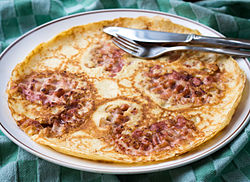Pannenkoek
This article needs additional citations for verification. (January 2011) |
 Pannenkoek with bacon | |
| Course | Main course |
|---|---|
| Place of origin | Netherlands |
| Region or state | Northwestern Europe |
| Serving temperature | Warm |
| Main ingredients | Flour, milk, and eggs |
A pannenkoek
Basic ingredients are flour (plain, self-rising or both), milk, salt, and eggs. The addition of buckwheat flour (up to 50 percent) is traditional, but much less common nowadays. Milk can be replaced with soy milk without changing the end result.
The ingredients are beaten into a batter of a fairly liquid consistency. A ladle of batter is then pan fried in butter or oil. Once the top of the pannenkoek is dry and the edges start to brown, it can be flipped over. The first one is often less than perfect. At home a stack of pannenkoeken can be made in advance so everyone can eat at the same time, or people can take turns at the stove.
Pannenkoeken can be, and often are, eaten as a main course, served warm; in winter pannenkoeken are sometimes eaten after
Dutch and Belgian supermarkets offer pre-cooked (microwavable) pannenkoeken as well as pre-made batter and dry flour mixes. The latter only needs added water.
Regional variations
In South Africa, pannenkoek is typically used in singular: "Kom ons eet pannekoek" (Let's eat pannenkoek) (Pannenkoek is Pannekoek in Afrikaans and South Africa) It is served with cinnamon and sugar; the cinnamon sugar mix is sprinkled over the pancake which is then rolled up and—unless consumed instantly—will be wrapped in wax paper to maintain warmth. The cinnamon and sugar melts into this warm and soft treat. It is often prepared as you watch at church bazaars, school fetes, and most any outdoor event which serves freshly cooked food such as barbecue (braaivleis).
As a former Dutch colony, Indonesia also inherited the dish. It is locally known as panekuk and is often eaten with creams inside and sweet dressings such as honey, condensed milk, hagelslag, or simply sprinkled with sugar. It is also a common practice to mix the batter with sliced banana fruits.
See also
- Crêpe
- Clafoutis
- Flaugnarde
- Kaiserschmarrn, an Austrian version
- Okonomiyaki, a Japanese savory pancake with many fillings
- Pannukakku, a Finnish version
- Palatschinke
References
- Witte Boekje, which is a private spelling norm, allows both. See "Pannekoek of pannenkoek?". Genootschap Onze Taal. Retrieved 12 January 2011.
- ^ "pannenkoek / pannekoek*". www.taaltelefoon.be (in Dutch). Retrieved 2018-01-09.
- ISBN 978-1-59158-321-9.